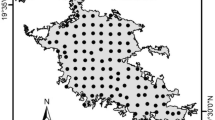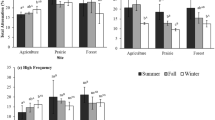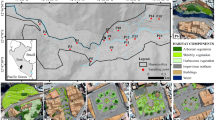Abstract
Anthropogenic noise is becoming a dominant component of soundscapes across the world and these altered acoustic conditions may have severe consequences for natural communities. We modeled noise amplitudes from gas well compressors across a 16 km2 study area to estimate the influence of noise on avian habitat use and nest success. Using species with noise responses representative of other avian community members, across the study area we estimated gray flycatcher (Empidonax wrightii) and western scrub-jay (Aphelocoma californica) occupancy, and gray flycatcher nest success, which is highly dependent on predation by western scrub-jays. We also explore how alternative noise management and mitigation scenarios may reduce area impacted by noise. Compressor noise affected 84.5% of our study area and occupancy of each species was approximately 5% lower than would be expected without compressor noise. In contrast, flycatcher nest success was 7% higher, reflecting a decreased rate of predation in noisy areas. Not all alternative management and mitigation scenarios reduced the proportion of area affected by noise; however, use of sound barrier walls around compressors could reduce the area affected by noise by 70% and maintain occupancy and nest success rates at levels close to those expected in a landscape without compressor noise. These results suggest that noise from compressors could be effectively managed and, because habitat use and nest success are only two of many ecological processes that may change with noise exposure, minimizing the anthropogenic component of soundscapes should be a conservation priority.






Similar content being viewed by others
References
Barber JR, Crooks KR, Fristrup KM (2010) The costs of chronic noise exposure for terrestrial organisms. Trends Ecol Evol 25:180–189
Bayne EM, Hobson KA (2001) Effects of habitat fragmentation on pairing success of ovenbirds: importance of male age and floater behavior. Auk 118:380–388
Bayne EM, Habib L, Boutin S (2008) Impacts of chronic anthropogenic noise from energy-sector activity on abundance of songbirds in the boreal forest. Conserv Biol 22:1186–1193
Bonier F, Martin PR, Wingfield JC (2007) Urban birds have broader environmental tolerance. Biol Lett 3:670–673
Bowker KA (2007) Barnett Shale gas production, Fort Worth basin: issues and discussion. AAPG Bull 91:523–533
Bureau of Land Management [BLM] (2003) Farmington resource management plan with record of decision. Bureau of Land Management, US Department of Interior, Farmington Field Office, Farmington
Burnham KP, Anderson DR (2002) Model selection and inference: a practical information-theoretic approach. Springer-Verlag, New York
Curry RL, Peterson AT, Langen TA (2002) Western Scrub-Jay (Aphelocoma californica). In: Poole A (ed) The birds of North America online. Cornell Lab of Ornithology, Ithaca, NY. Available from http://bna.birds.cornell.edu.bnaproxy.birds.cornell.edu/bna/species/712. Accessed 22 January 2011
Egnor SER, Wickelgren JG, Hauser MD (2007) Tracking silence: adjusting vocal production to avoid acoustic interference. J Comp Physiol A 193:477–483
Engler TW, Brister BS, Chen H-Y, Teufel LW (2001) Oil and gas resource development for San Juan basin. Report to Bureau of Land Management, Albuquerque Field Office, Albuquerque
ESRI (2008) ArcGis 9.3. ESRI, Redland
Forman RTT, Reineking B, Hersperger AM (2002) Road traffic and nearby grassland bird patterns in a suburbanizing landscape. Environ Manage 29:782–800
Francis CD, Ortega CP, Cruz A (2009) Noise pollution changes avian communities and species interactions. Curr Biol 19:1415–1419
Francis CD, Ortega CP, Cruz A (2011) Vocal frequency change reflects different responses to anthropogenic noise in two suboscine tyrant flycatchers. Proc Royal Soc B. doi:10.1098/rspb.2010.1847
Gross K, Pasinelli G, Kunc HP (2010) Behavioral plasticity allows short-term adjustment to a novel environment. Am Nat 176. doi:10.1086/655428
Habib L, Bayne EM, Boutin S (2007) Chronic industrial noise affects pairing success and age structure of Overbirds Seiurus aurocapilla. J Appl Ecol 44:176–184
Halfwerk W, Holleman LJM, Lessells CM, Slabbekoorn H (2011) Negative impact of traffic noise on avian reproductive success. J Appl Ecol 48:210–219
Holmes RT, Marra PP, Sherry TW (1996) Habitat-specific demography of breeding black-throated blue warblers (Dendroica caerulescens): implications for population dynamics. J Anim Ecol 65:183–195
Kargbo DM, Wilhelm RG, Campbell DJ (2010) Natural gas plays in the Marcellus Shale; challenges and potential opportunities. Environ Sci Technol 44:5679–5684
Lowther PE (1993) Brown-headed Cowbird (Molothrus ater). In: Poole A (ed) The birds of North America online. Cornell Lab of Ornithology, Ithaca, NY. Available from http://bna.birds.cornell.edu.bnaproxy.birds.cornell.edu/bna/species/047. Accessed January 2011
Nemeth E, Brumm H (2009) Blackbirds sing higher-pitched songs in cities: adaptation to habitat acoustics or side-effect of urbanization? Anim Behav 78:637–641
Occupational Safety and Health Administration (OSHA) (2009). Available from http://www.osha.gov/SLTC/noisehearingconservation/index.html
Pacifici K, Simons TR, Pollock KH (2008) Effects of vegetation and background noise on the detection process in auditory avian point-count surveys. Auk 125:600–607
Parris KM, Velik-Lord M, North JMA (2009) Frogs call at a higher pitch in traffic noise. Ecol Soc 14:25. Available from http://www.ecologyandsociety.org/vol14/iss1/art25
R Development Core Team (2009) R: a language and environment for statistical computing. R Foundation for Statistical Computing, Vienna
Rabin LA, Coss RG, Owings DH (2006) The effects of wind turbines on antipredator behavior in California ground squirrels (Spermophilus beecheyi). Biol Conserv 131:410–420
Reijnen R, Foppen R, ter Braak C, Thissen J (1995) The effects of car traffic on breeding bird populations in Woodland. III. Reduction of density in relation to the proximity of main roads. J Appl Ecol 32:187–202
Rheindt FE (2003) The impact of roads on birds: does song frequency play a role in determining susceptibility to noise pollution? J Ornithol 144:295–306
Saether B-E (1990) Age-specific variation in reproductive performance of birds. Curr Ornithol 7:251–283
Schafer RM (1977) The soundscape: our sonic environment and the tuning of the world. Destiny Books, Rochester, Vermont
Shaffer TL (2004) A unified approach to analyzing nest success. Auk 121:526–540
Slabbekoorn H, Bouton N (2008) Soundscape orientation: a new field in need of sound investigation. Anim Behav 76:e5–e8
Slabbekoorn H, Halfwerk W (2009) Behavioural ecology: noise annoys at community level. Curr Biol 19:R693–R695
Slabbekoorn H, Peet M (2003) Birds sing at a higher pitch in urban noise. Nature 424:267
Sterling JC (1999) Gray Flycatcher (Empidonax wrightii). In: Poole A, (ed) The birds of North America online. Cornell Lab of Ornithology, Ithaca, NY. Available from http://bna.birds.cornell.edu.bnaproxy.birds.cornell.edu/bna/species/458. Accessed September 2010
Vermeij MJA, Marhaver KL, Huijbers CM, Nagelkerken I, Simpson SD (2010) Coral larvae move toward reef sounds. PLoS One 5:e10660
Acknowledgments
We thank our research assistants for field and lab support, especially R. Kennedy, N. Kleist, and P. Nylander, and BLM Farmington Field Office Biologist J. Hansen. We also thank two anonymous reviewers for useful suggestions and comments on an earlier version of this manuscript. This study was primarily supported by NSF DDIG (# IOS 0910092), BLM, through the Colorado Plateau Cooperative Ecosystems Studies Unit, ConocoPhillips, Williams Energy, and University of Colorado Department of Ecology and Evolutionary Biology, plus the Animal Behavior Society, Southwestern Association of Naturalists, Colorado Field Ornithologists, Edna Baily Sussman Foundation, Mountain Studies Institute, and an Ariel Appleton Research Fellowship with support from the Wells Fargo Foundation. C.D.F. was also supported by the National Evolutionary Synthesis Center (NESCent, NSF EF-0905606).
Author information
Authors and Affiliations
Corresponding author
Rights and permissions
About this article
Cite this article
Francis, C.D., Paritsis, J., Ortega, C.P. et al. Landscape patterns of avian habitat use and nest success are affected by chronic gas well compressor noise. Landscape Ecol 26, 1269–1280 (2011). https://doi.org/10.1007/s10980-011-9609-z
Received:
Accepted:
Published:
Issue Date:
DOI: https://doi.org/10.1007/s10980-011-9609-z




